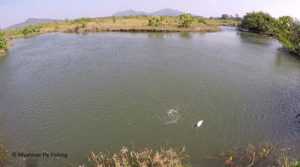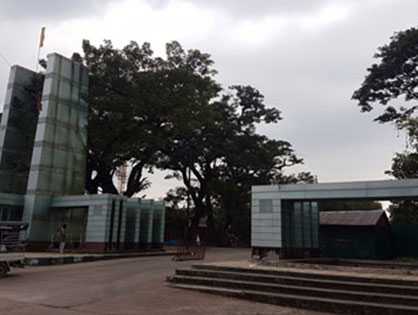
Family: Megalopidae
Order: Elopiformes
Myanmar Name(s): Nga-kun-nya
Occurrence: Native
Description (Source: Wikipedia)
In appearance, it is like the Atlantic tarpon, Megalops atlanticus: olive-green on top, and silver on the sides. The large mouth is turned upwards; the lower jaw contains an elongated, bony plate. The last ray of the dorsal fin is much longer than the others, reaching nearly to the tail. It is capable of filling its swim bladder with air and absorbing oxygen from it. Those living in fresh water tend to be smaller than the ones living in saltwater, growing just over 50 cm (20 in), while saltwater examples grow over 1 m (3.3 ft). They live upwards of 44 years and mature within two.
Biology / Diet / Behavior (Source: Wikipedia)
They are opportunistic feeders, feeding on smaller fish, crustaceans, and even plants rarely. In saltwater, they mainly feed on prawns and herring, but also many other small fish. In fresh water, no significant difference in their food habits is seen; they eat freshwater prawns and bony bream, mainly.
The Indo-Pacific tarpon migrates between the open sea and inland rivers. It spawns mainly offshore. Juveniles of the species stay inshore and migrate to coastal areas while maturing to spawn. Typically, they spawn twice a year. At sea, the larvae migrate inland and are leptocephalic (flattened, transparent and eel-like). Unlike the barramundi, they are able to breed in fresh and salt water.
They are found in depths to 50 m (160 ft), but are commonly found by the surface in shallow inshore waters. They inhabit coral reefs, mangroves, swamps, rivers, lakes, reservoirs, floodplains, and canals.

Fly Fishing For Tarpon In Myanmar: What We Understand & Know So Far...
So far, we have only caught tarpons in Tanintharyi Division, in the South of Myanmar. We caught them in a small creek largely influenced by tidal fluctuations where water is fresh to brakish.
Due to their very bony mouth, it is actually hard to set the hook, leading to a low capture rate in comparison to the number of takes. A small fly with a small hook works better than bigger flies, as it is easier to swallow for the tarpon.
They appear in schools in deeper pools, usually close to the main current, but slightly on the side.
Once hooked, they pull hard and jump a lot, making them lots of fun to catch.













